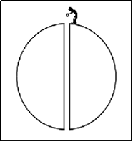While it takes only a small deflection to nullify an Oort cloud object's angular momentum...Chris Peterson wrote:Not sure what you mean by "what are the odds". There may be billions of bodies in the Oort cloud, so the chance that any one of them will be perturbed into the inner system is small. But such perturbations are common, happening every few years. So in that sense, the odds are high.Spif wrote:
So what I'm wondering is, what are the odds? Whatever nudged this comet initially must have been pretty severe to divert it from a presumably stable orbit way out there and subsequently aim it almost directly at the sun? That must have been a huge deflection.
Bodies that distance from the Sun are bound only very lightly. While their orbits may be seen as stable, they need only the slightest perturbation- just a few meters per second- to reach escape velocity. Nothing more than a close pass from another small body, a chance positioning of the planets, or even the position of a nearby star can be enough to generate the necessary delta-v. So these bodies are very easily deflected into highly eccentric orbits that pass close to the Sun. It isn't a large deflection at all.
how does the angular momentum get canceled out almost completely
This will be the first pass of Comet ISON (C/2012 S1) and it has an eccentricity ~ 1.0000021.
You've got to figure that the chance of changing from a small quasi-circular Oort cloud eccentricity of 0.3 ± 0.3
to a quasi-parabolic sungrazer eccentricity of 1.0 ± 0.0000021 must be about 1 in 100,000.
(Where's Ernst Mach when you need him?)

